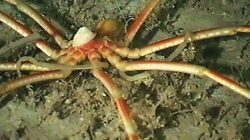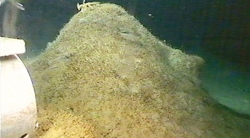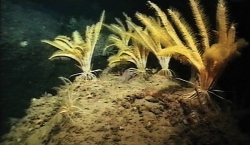The Storegga slide off the middle coast of Norway is one of the world's largest known underwater landslides. Discovered in the 1960s by Norwegian geologists, the slide occurred more than 8,100 years ago when an area of land approximately the size of Denmark slumped into the Norwegian Sea, triggering a very large tsunami. The Storegga slide was last in a series of huge underwater slides in this region during the past million years. The northern flank of the Storegga slide area (64°45'N, 5°E), which was fully surveyed by Statoil in 2004 using remotely operated vehicles, is known as Nyegga, or "new scarp", and sits at water depths of 600–800 meters.

A sea spider (Collossendeis probiscae) measuring 15 cm wide. Attached to its back is a large, white foraminifer. Photo courtesy M. Hovland.
Statoil's detailed seabed survey revealed a rugged seafloor terrain consisting of large complex pockmark craters approximately 200–300 meters in diameter with thick piles of carbonate rocks and sediment mounds within them. The team also found surprisingly abundant fish and invertebrates, including giant deep sea spiders and stalked crinoids, at sub-zero water temperatures (-0.7 ° C). The seepage of hydrocarbons through the seafloor explains both the locally diverse, dense biology and unique topography. These light hydrocarbons, dominated by methane but also including ethane, propane, and butane, originate at considerable depth below the Earth's surface in a thermogenic hydrocarbon-generating region where organic matter is turned into oil and gas at relatively high temperatures and pressures. These gases exit through the seafloor at distinct, focused vent sites where the immediately surrounding seafloor sediments are poisoned, becoming anoxic as the hydrocarbons are oxidized at the sediment-water boundary. These locations are made visible by bacterial mats forming at the oxylimnion (the boundary where anoxic and oxic conditions meet).

A typical hydrate pingo measuring approximately one meter in height. Observations suggest that the shape and appearance of these pingoes change from year to year as the gas hydrates within continually form and melt over time. Photo courtesy M. Hovland.
Fuelled by the hydrocarbons, the abundant marine life in these areas demonstrates that such "cold seeps" represent important nutrient hubs, where primary producers—bacteria, archaea, and viruses—turn hydrocarbons into proteins available for higher trophic levels. Methane, the hydrocarbon with the highest hydrogen-to-carbon ratio, represents a particularly high-energy substrate for some of the microorganisms—specifically, the methanogens, which synthesize the compound for growth in anaerobic conditions.
At such great water depths, high ambient pressure can also cause hydrocarbon gases to combine with water molecules to form ice-like gas hydrates. At seep locations where this occurs, the seafloor is locally unstable, and small sediment domes, or pingoes, are formed. These hydrate-pingoes resemble pure ice pingoes known from terrestrial tundra areas. They may also manifest the exact locations where fluid flow through the seafloor is currently active and could be used as indicators of active seepage.

Stalked crinoids on a carbonate rock 725 m below the surface. Although these invertebrates are passive suspension feeders, they can move through the water column and along the sea floor at speeds up to 1 meter per second. Photo courtesy M. Hovland.
Since Statoil's 2004 discoveries at Nyegga, a series of international research teams and vessels have visited this site. Scientists aboard the Russian vessel Professor Logachev obtained samples of the gas hydrates within the pingoes in 2006. The same year, a British and French research team aboard the Pourquoi Pas documented small tubeworms (Pogonophora) at the site, which are totally dependent upon internal bacteria for sustaining life. The bacteria utilize the seeping methane in their metabolism and make up about 60% of the tubeworms' weight.
Currently Statoil has no plans for further research or development in the Nyegga area. For more information, contact Martin Hovland, Marine Geology Specialist at Statoil (MHOVLAND [at] StatoilHydro.com).
